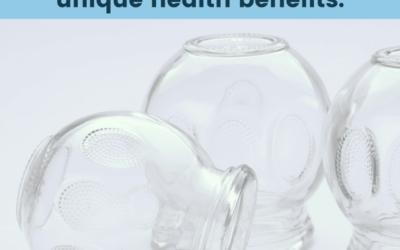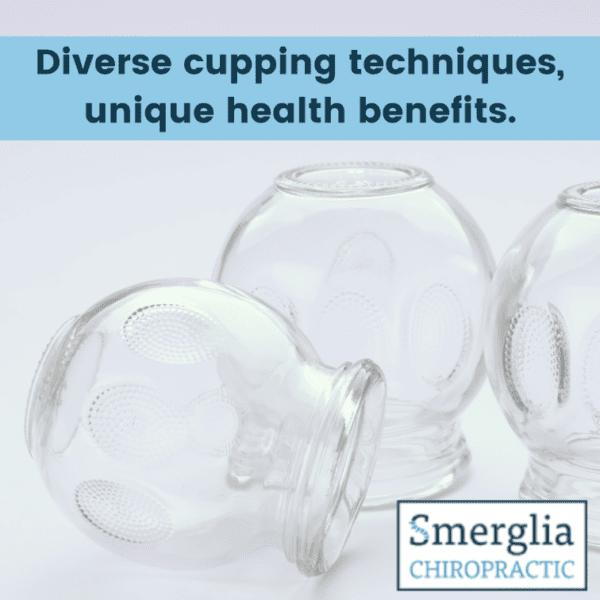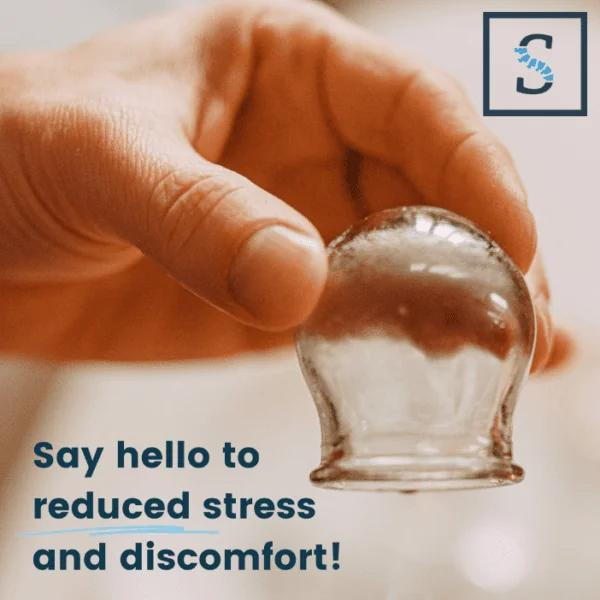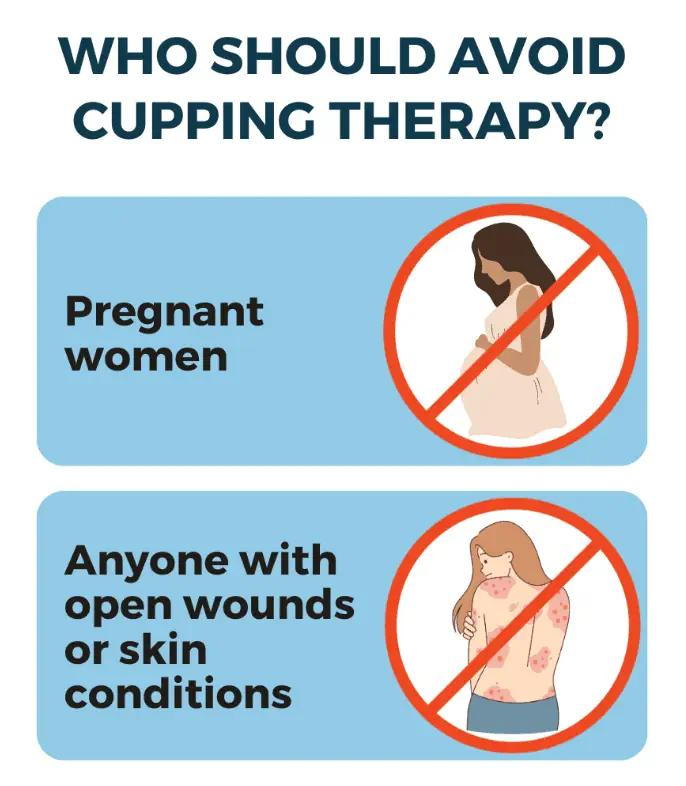
Cupping for Pain Relief: Is it right for you?
- posted: Sep. 29, 2023
Cupping therapy, a traditional Chinese medicinal practice, has gained popularity in recent years as a natural alternative for pain relief. While cupping may offer several benefits, it’s important to understand that it’s not a one-size-fits-all solution. In this blog, we’ll explore what cupping entails, the range of conditions it can address, and circumstances where it may not be suitable.
Understanding Cupping Therapy
Cupping involves placing special cups on the skin to create suction, promoting blood flow and stimulating healing. The cups can be made of various materials like glass, silicone, or bamboo. Cupping aims to alleviate discomfort and restore balance in the body by targeting specific acupuncture points or areas of pain.
There are two primary cupping methods – dry cupping and wet cupping. Each technique is unique and offers different benefits. Dry cupping involves suction only, whereas wet cupping includes a small incision to draw blood, which is believed to promote healing. Both techniques are commonly practiced by acupuncturists, chiropractors, physical therapists, massage therapists specializing in deep tissue massage, and medical doctors. At Smerglia Chiropractic, we utilize dry cupping when it’s appropriate for a client’s health, condition, and goals.

Dry Cupping Technique
Dry cupping is non-invasive and uses suction cups on the skin for 5-15 minutes, drawing the skin and muscle tissue into the cups. This action creates a negative pressure, causing the muscle tissue to lift and stretch. The process can:
- alleviate pain
- boost circulation
- reduce inflammation
- induce muscle relaxation
The Science Behind Cupping and Pain Relief
Increased Blood Flow
Cupping therapy uses suction to draw fluid into the treated area, causing blood vessels to expand and rupture, thereby stimulating healing and improving blood flow. Increasing blood flow has numerous benefits, such as reducing inflammation, improving circulation, and facilitating healing.
While cupping therapy has benefits for many, it isn’t suitable for all. Those with bleeding disorders, high blood pressure, or heart disease should proceed with caution and be prepared for their healthcare provider to discourage cupping therapy and instead recommend other treatments.
Muscle Tension Reduction
Cupping can help reduce muscle tension by lifting and stretching the muscle tissue, promoting relaxation and increased range of motion. This can enhance flexibility and decrease pain and discomfort in the affected muscles.
However, there are some situations where cupping therapy should not be employed for relieving muscle tension. Individuals with open wounds, pregnant women, or those with skin conditions such as eczema or psoriasis should avoid cupping therapy to prevent potential complications.

Conditions Cupping Can Treat
Cupping therapy may be effective in treating various pain conditions, including chronic pain, such as neck pain, shoulder pain, and carpal tunnel syndrome. By enhancing blood flow to the affected area, reducing muscle tension, and providing relief from pain, cupping can complement conventional pain relief methods.
Before initiating cupping therapy – or any therapy for any pain-related conditions – talk to your healthcare provider. While some may find relief through cupping, it’s vital to ascertain the therapy’s suitability for your specific circumstances and medical history.
Neck Pain
Cupping may help alleviate neck pain by increasing blood flow and reducing muscle tension in the affected area. Neck pain can result from various factors, such as poor posture, neck injuries, or other causes. Cupping therapy can relieve neck pain and improve overall comfort by improving blood flow and reducing muscle tension.
Collaborating with a qualified healthcare professional is key to identifying the right cupping techniques and devising a treatment plan for your specific neck pain condition. Combining cupping therapy with other treatments, such as physical therapy or massage, may enhance the overall effectiveness of the treatment plan.
Shoulder Pain
Shoulder pain may be relieved through cupping therapy by promoting relaxation and increased range of motion in the shoulder muscles. By lifting and stretching the muscle tissue, cupping therapy can help reduce pain, enhance circulation, and alleviate inflammation in the shoulder area.
Similar to neck pain, consulting a qualified healthcare professional to pinpoint suitable cupping techniques and formulate a treatment plan for your specific shoulder pain condition is crucial. Again, combining cupping therapy with other treatments for shoulder pain, such as physical therapy or massage, may enhance the overall effectiveness of the treatment plan.
Carpal Tunnel Syndrome
Cupping therapy may be an effective complementary treatment for carpal tunnel syndrome, a prevalent condition that induces numbness, tingling, and distress in the hand and forearm. Carpal tunnel syndrome occurs when there is pressure on the median nerve as it passes through the carpal tunnel in the wrist.
Working with a qualified healthcare professional, such as a physical therapist or chiropractor, can help determine the appropriate combination of cupping therapy and other treatments for carpal tunnel syndrome. By incorporating cupping therapy with physical therapy or other interventions, individuals may find relief from the symptoms of carpal tunnel syndrome and improve their overall quality of life.

When to Avoid Cupping Therapy
Cupping therapy is not suitable for everyone and should be avoided in certain situations. For instance, pregnant women should avoid cupping therapy, as it may cause complications. Individuals with open wounds or skin conditions, such as eczema or psoriasis, should also avoid cupping therapy to prevent potential skin infections or complications.
Moreover, cupping therapy may exacerbate certain medical conditions, including high blood pressure, heart disease, and diabetes. Talk to your healthcare provider to determine the best course of treatment for you and your needs before embarking on any pain-relief treatment, including cupping.
Smerglia Chiropractic Can Help
At Smerglia Chiropractic, our holistic approach to health and wellness includes non-invasive, drug-free treatment – including cupping – for a wide range of ailments, including chronic pain and musculoskeletal conditions. Reach out to learn more about how we can help you manage your pain and discomfort today.

Cupping for Pain Relief: Is it right for you?
- posted: Sep. 29, 2023
Cupping therapy, a traditional Chinese medicinal practice, has gained popularity in recent years as a natural alternative for pain relief. While cupping may offer several benefits, it’s important to understand that it’s not a one-size-fits-all solution. In this blog, we’ll explore what cupping entails, the range of conditions it can address, and circumstances where it may not be suitable.
Understanding Cupping Therapy
Cupping involves placing special cups on the skin to create suction, promoting blood flow and stimulating healing. The cups can be made of various materials like glass, silicone, or bamboo. Cupping aims to alleviate discomfort and restore balance in the body by targeting specific acupuncture points or areas of pain.
There are two primary cupping methods – dry cupping and wet cupping. Each technique is unique and offers different benefits. Dry cupping involves suction only, whereas wet cupping includes a small incision to draw blood, which is believed to promote healing. Both techniques are commonly practiced by acupuncturists, chiropractors, physical therapists, massage therapists specializing in deep tissue massage, and medical doctors. At Smerglia Chiropractic, we utilize dry cupping when it’s appropriate for a client’s health, condition, and goals.

Dry Cupping Technique
Dry cupping is non-invasive and uses suction cups on the skin for 5-15 minutes, drawing the skin and muscle tissue into the cups. This action creates a negative pressure, causing the muscle tissue to lift and stretch. The process can:
- alleviate pain
- boost circulation
- reduce inflammation
- induce muscle relaxation
The Science Behind Cupping and Pain Relief
Increased Blood Flow
Cupping therapy uses suction to draw fluid into the treated area, causing blood vessels to expand and rupture, thereby stimulating healing and improving blood flow. Increasing blood flow has numerous benefits, such as reducing inflammation, improving circulation, and facilitating healing.
While cupping therapy has benefits for many, it isn’t suitable for all. Those with bleeding disorders, high blood pressure, or heart disease should proceed with caution and be prepared for their healthcare provider to discourage cupping therapy and instead recommend other treatments.
Muscle Tension Reduction
Cupping can help reduce muscle tension by lifting and stretching the muscle tissue, promoting relaxation and increased range of motion. This can enhance flexibility and decrease pain and discomfort in the affected muscles.
However, there are some situations where cupping therapy should not be employed for relieving muscle tension. Individuals with open wounds, pregnant women, or those with skin conditions such as eczema or psoriasis should avoid cupping therapy to prevent potential complications.

Conditions Cupping Can Treat
Cupping therapy may be effective in treating various pain conditions, including chronic pain, such as neck pain, shoulder pain, and carpal tunnel syndrome. By enhancing blood flow to the affected area, reducing muscle tension, and providing relief from pain, cupping can complement conventional pain relief methods.
Before initiating cupping therapy – or any therapy for any pain-related conditions – talk to your healthcare provider. While some may find relief through cupping, it’s vital to ascertain the therapy’s suitability for your specific circumstances and medical history.
Neck Pain
Cupping may help alleviate neck pain by increasing blood flow and reducing muscle tension in the affected area. Neck pain can result from various factors, such as poor posture, neck injuries, or other causes. Cupping therapy can relieve neck pain and improve overall comfort by improving blood flow and reducing muscle tension.
Collaborating with a qualified healthcare professional is key to identifying the right cupping techniques and devising a treatment plan for your specific neck pain condition. Combining cupping therapy with other treatments, such as physical therapy or massage, may enhance the overall effectiveness of the treatment plan.
Shoulder Pain
Shoulder pain may be relieved through cupping therapy by promoting relaxation and increased range of motion in the shoulder muscles. By lifting and stretching the muscle tissue, cupping therapy can help reduce pain, enhance circulation, and alleviate inflammation in the shoulder area.
Similar to neck pain, consulting a qualified healthcare professional to pinpoint suitable cupping techniques and formulate a treatment plan for your specific shoulder pain condition is crucial. Again, combining cupping therapy with other treatments for shoulder pain, such as physical therapy or massage, may enhance the overall effectiveness of the treatment plan.
Carpal Tunnel Syndrome
Cupping therapy may be an effective complementary treatment for carpal tunnel syndrome, a prevalent condition that induces numbness, tingling, and distress in the hand and forearm. Carpal tunnel syndrome occurs when there is pressure on the median nerve as it passes through the carpal tunnel in the wrist.
Working with a qualified healthcare professional, such as a physical therapist or chiropractor, can help determine the appropriate combination of cupping therapy and other treatments for carpal tunnel syndrome. By incorporating cupping therapy with physical therapy or other interventions, individuals may find relief from the symptoms of carpal tunnel syndrome and improve their overall quality of life.

When to Avoid Cupping Therapy
Cupping therapy is not suitable for everyone and should be avoided in certain situations. For instance, pregnant women should avoid cupping therapy, as it may cause complications. Individuals with open wounds or skin conditions, such as eczema or psoriasis, should also avoid cupping therapy to prevent potential skin infections or complications.
Moreover, cupping therapy may exacerbate certain medical conditions, including high blood pressure, heart disease, and diabetes. Talk to your healthcare provider to determine the best course of treatment for you and your needs before embarking on any pain-relief treatment, including cupping.
Smerglia Chiropractic Can Help
At Smerglia Chiropractic, our holistic approach to health and wellness includes non-invasive, drug-free treatment – including cupping – for a wide range of ailments, including chronic pain and musculoskeletal conditions. Reach out to learn more about how we can help you manage your pain and discomfort today.
